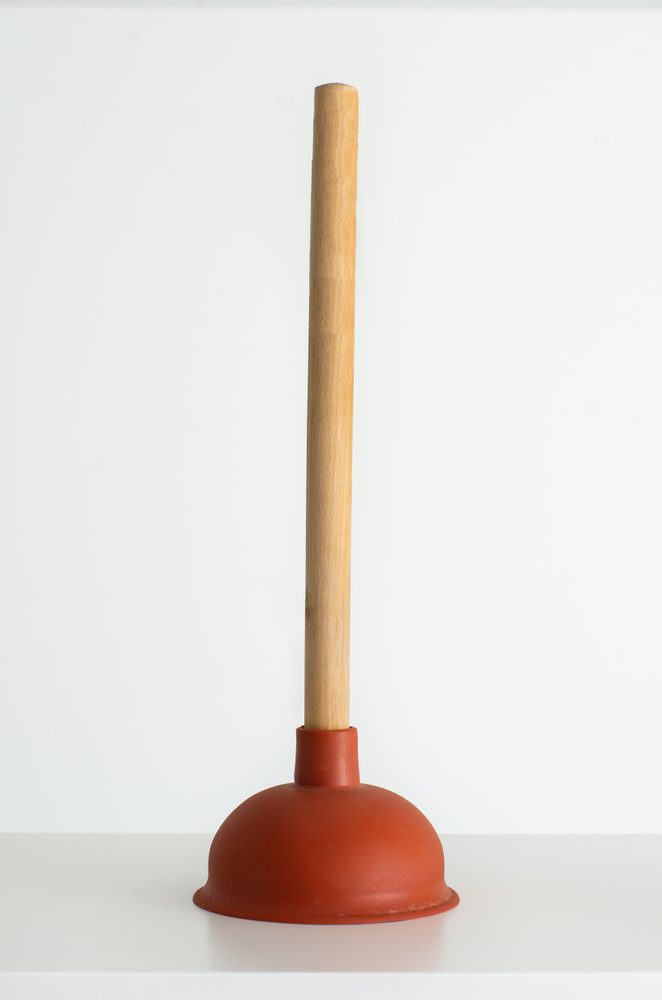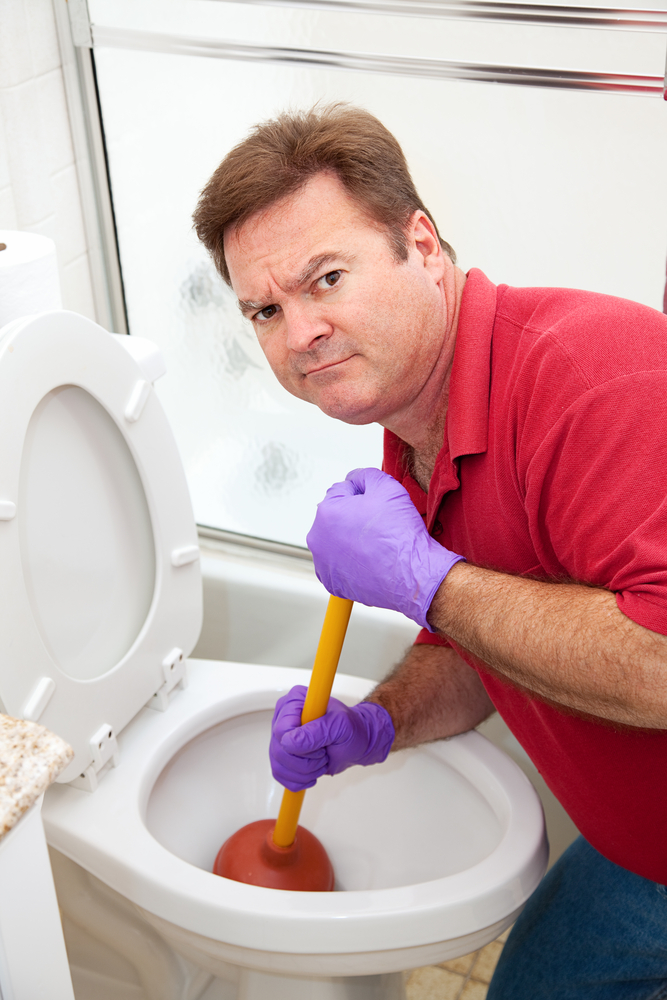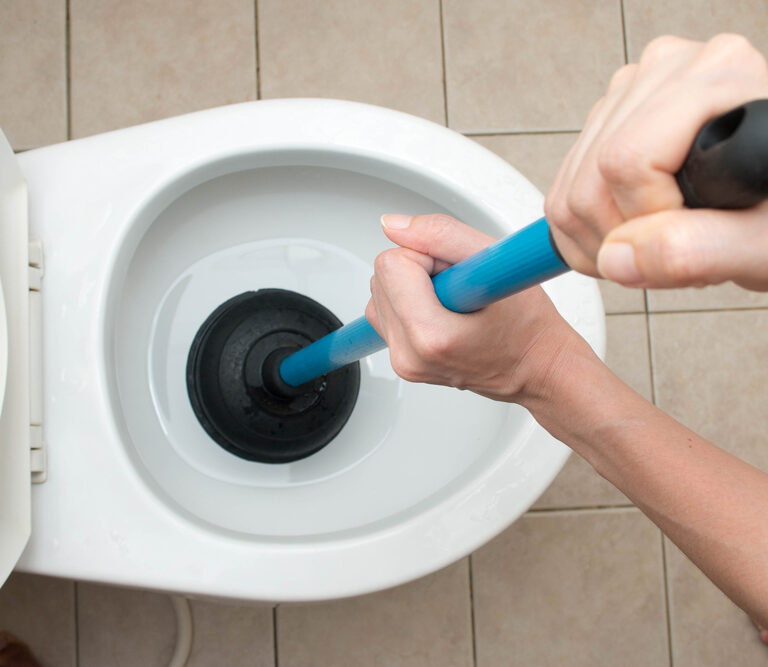We can safely say, without hyperbole, that there’s no worse feeling in the world than flushing the toilet and watching as nothing goes down. Quite the opposite, in fact — things start rising, including many things that you don’t want to have to pick up off your bathroom floor.
That’s where your trusty old toilet plunger comes in. While it may not look like much, the toilet plunger has saved countless people from embarrassing situations and disgusting cleanups.
Despite both its simplicity and utility, though, many people don’t realize how to use one properly. In this guide, we’ll explain the correct way to plunge a toilet — because if you get it wrong, you could end up in deep… well, you know.
How Does a Toilet Plunger Work?
There is a number of reasons why a toilet might become clogged, from using too much toilet paper to getting a foreign object lodged inside. While a plunger might not work in every case, it’s a good starting point.
The way a toilet plunger works is simple. The rubber forms an airtight seal around the hole in the toilet, trapping water between the plunger and the blockage.
When you push down on the plunger, water is forced towards the blockage with great force. This might be enough to dislodge it and get your toilet running again.
If that doesn’t do the trick, though, pulling back on the plunger will create a tremendous amount of suction. This can also help move the blockage.
It’s important to realize that your goal isn’t to move the clog very far. If you can get it to budge just a little bit, the water pressure will be enough to clear it out and get everything up and running again.
Make Sure You Have the Right Plunger Before You Get Started
This may seem strange to you, but someone once looked at a plunger and thought, “It’s good, but I bet I could do better.” They then redesigned it.
This may seem even stranger to you, but that process happened three different times.
That’s right, there are four different types of plungers, and they’re all designed for different things. Let’s take a look at your options, as well as reveal which one is best for plunging a toilet.
1. Standard Plunger

This is probably what you think of when you think of a plunger. It’s a simple rubber cup with a stick coming out of one end.
The standard plunger may well be what you have in your bathroom — but it shouldn’t be. It’s designed to sit over drains in flat surfaces, like sinks. As such, it’s difficult to position it in such a way that you get an airtight seal in your toilet.
2. Taze Plunger
The taze plunger looks a lot like a standard plunger, except it’s bigger. A lot bigger. Also, the handle is usually made of steel, not wood. You’ll likely only see a taze plunger in a plumber’s truck, rather than in a residential bathroom.
Taze plungers are designed for industrial-strength jobs, so hopefully you don’t need one in your house. If you do, consider cutting back on the fiber.
3. Accordion Plunger
Now we’re getting somewhere. Of the three plunger types we’ve covered so far, the accordion plunger is the best for clearing out clogged toilets — but it still wouldn’t be our first pick.
These hard plastic devices have a small cup on one end designed to fit over toilet holes. Just behind the cup is an accordion structure that allows you to build up pressure, and it all culminates in a baseball bat-like plastic handle.
Accordion plungers allow you to create a lot of pressure — if you can get them to work, that is. There’s quite the learning curve, and even pros can have trouble getting them sealed properly. Also, they’re really only suitable for use on toilets, so you’d need to own multiple plungers.
4. Toilet Plunger
Ah, here we go — our top choice for unstopping a clogged toilet. In retrospect, the fact that it’s called a “toilet plunger” was a pretty good clue that this is the one to use.
Toilet plungers look just like standard plungers, except they have a soft rubber flap sticking out of the cup. This flap is perfect for closing up the hole in your toilet, creating a vacuum seal that makes it easy to create a ton of suction.
Better yet, that flap can be folded in if you need to unclog something other than a toilet, turning the thing into a standard plunger. It’s the best of both worlds (but maybe buy a separate one for using in the sink).
How to Plunge a Clogged Toilet
Now that we’ve given you a crash course in plunger theory, it’s time to show you just how to clear that stopped toilet.
You’ll need a suitable plunger, some rubber gloves if you don’t want to worry about touching toilet water, and possibly some Vaseline to rub on the cup to give you a tighter seal.
Oh, and if you’re at a friend’s house, you’ll want to have some music loud enough to cover up all the plunging sounds and cursing as well.
1. Clear the Area
No matter how careful you are, there’s always the risk that you’ll splash dirty water out of the toilet while plunging. That means that you should move any clothes, mats, or reading material out of the way before you get started.
You can also lay some old towels or rags down if you like, just to be on the safe side.
2. Don’t Remove Water if You Don’t Have To
Unless the bowl is so full that you can’t plunge without sending water everywhere, you shouldn’t bail out any of the liquid inside. There needs to be at least enough water to cover the head of the plunger.
This ensures you’ll have enough water to attack the clog with, since otherwise you’ll have to rely on air — and air is no match for a thick wad of toilet paper or that G.I. Joe your kid doomed to a watery grave.
3. Start off Slow
We know, we know — this clog has ticked you off, and you want to send it to hell as dramatically as possible. While we understand the sentiment, you shouldn’t bring that plunger down like you’re driving a stake into Dracula’s heart.
The first few plunges should be slow and gentle. Not only does this minimize the mess, but there’s a good chance that you won’t need to work any harder than that to get the job done.
Also, the cup of the plunger will be full of air on the first plunge. If you plunge as hard as you can, that air can be forced out, breaking the seal and sending toilet water flying back at you. It’s like being at the world’s worst Gallagher show.
4. Build up a Good Rhythm
After you’ve given it a few gentle plunges, it’s time to get serious. Build up a steady rhythm of more forceful strokes, being careful not to break the seal while doing so.
It could take a bit of time to work the clog loose, so don’t be surprised if it takes you 15 to 20 plunges to find success. You can also work in the occasional superhero plunge to try to jar the blockage loose—but again, don’t break your seal.
5. Know When to Quit
If after 30 seconds or so of steady plunging you’re no closer to success than when you started, it’s time to admit defeat. This may be a serious clog, so you should call a plumber — or break out the toilet snake, if you have one.
When Not to Use a Plunger
While a toilet plunger is a smart first step for dealing with a clogged toilet, there’s one time when you should never use one — and that’s when you’ve poured a chemical drain opener (like Drano) into the bowl.
If you plunge the toilet with the chemicals still inside, they could splash back onto you, injuring your eyes or skin. Wait until you’re sure the toilet is cleared out before plunging, or call a professional.
Better yet, don’t put any of those chemicals in your toilet at all. Not only are they less effective than plunging, but they can damage the porcelain in the bowl or the plastic in your pipes.
Final Thoughts

Having a clogged toilet is a potentially messy and embarrassing situation, but as long as you have a plunger on hand, you can usually fix it in just a few seconds — provided you know what you’re doing.
Of course, if you don’t want to bother with plunging your commode, you can always use a more advanced technique: blaming the situation on the next person who goes into the bathroom.
